March 2022 LIP of the Month
Ca. 1750-1500 Ma mafic magmatic events in South China
Gui-Mei Lu1, Wei Wang1,2*, Peter A. Cawood2, Richard E. Ernst3,4, Massimo Raveggi2, Si-Fang Huang1, Er-Kun Xue1
1State Key Laboratory of Geological Processes and Mineral Resources, School of Earth Sciences, China University of Geosciences, Wuhan 430074, China. wwz@cug.edu.cn
2School of Earth, Atmosphere & Environment, Monash University, Melbourne, VIC 3800, Australia
3Department of Earth Sciences, Carleton University, Ottawa, Ontario K1S 5B6, Canada
4Faculty of Geology and Geography, Tomsk State University, 36 Lenin Ave, Tomsk 634050, Russia
Figures compiled from
Lu, G-M. et al., 2020. Late Paleo- to early Mesoproterozoic mafic magmatism in the SW Yangtze Block: Mantle plumes associated with Nuna breakup? Journal of Geophysical Research: Solid Earth 125(7) e2019JB019260.
Lu, G-M. et al., 2019. Petrogenesis of Paleo-Mesoproterozoic mafic rocks in the southwestern Yangtze Block of South China: Implications for tectonic evolution and paleogeographic reconstruction. Precambrian Research 322, 66-84.
Numerous late Paleoproterozoic to early Mesoproterozoic mafic magmatic rocks are exposed in the southwestern Yangtze Block of South China (Fig. 1), corresponding to the early breakup of the Columbia/Nuna supercontinent. The baddeleyite and zircon U-Pb dating on the mafic rocks from the Huili-Dongchuan region reveal three episodes of mafic magmatism at ~1740 Ma, 1700 Ma and 1500 Ma (Fig. 2). These results were further confirmed by Fan et al. (2020), which carried out a detailed zircon and baddeleyite SIMS U-Pb dating on the mafic rocks from the Huili-Dongchuan region. The two older generations have MORB-like Nb/Ta ratios and superchondritic Nd-Hf isotopes (Figs. 3 and 4), indicating that they were likely derived from partial melting of asthenospheric mantle. In contrast, the ~1500 Ma mafic rocks possess OIB-like Nb/Ta (16.7-19.1) and Zr/Hf (41.0-45.1) ratios, εNd (t) values (-0.8 to +0.1) and εHf (t) values (-3.3 to +8.4) (Figs. 3 and 4), suggesting that they originated from a mantle plume.
These three pulses of mafic magmatic activity in the Yangtze Block have geochemical features (such as TiO2 contents, Nb/Y and La/Yb values), similar to coeval mafic rocks in Siberia and Laurentia (Fig. 5), consistent with detrital zircon provenance studies which show a spatial linkage of the Yangtze Block with northern Laurentia and southern Siberia in the Columbia/Nuna configuration. Taking all synchronous mafic magmatism into account, a mantle plume beneath Siberia initiated at ~1750 Ma forming a broad region of mafic magmatism that extended into the Yangtze Block and resulted in lithospheric extension (Fig. 6). The Yangtze Block was possibly the nearest neighbor to western part of the Siberian Craton at ~1500 Ma (Fig. 6). It subsequently drifted from the Columbia/Nuna supercontinent induced by the ~1500 Ma Kuonamka mantle plume, heralding a period of limited magmatic activity and tectonic quiescence that extended throughout the remainder of the Mesoproterozoic.
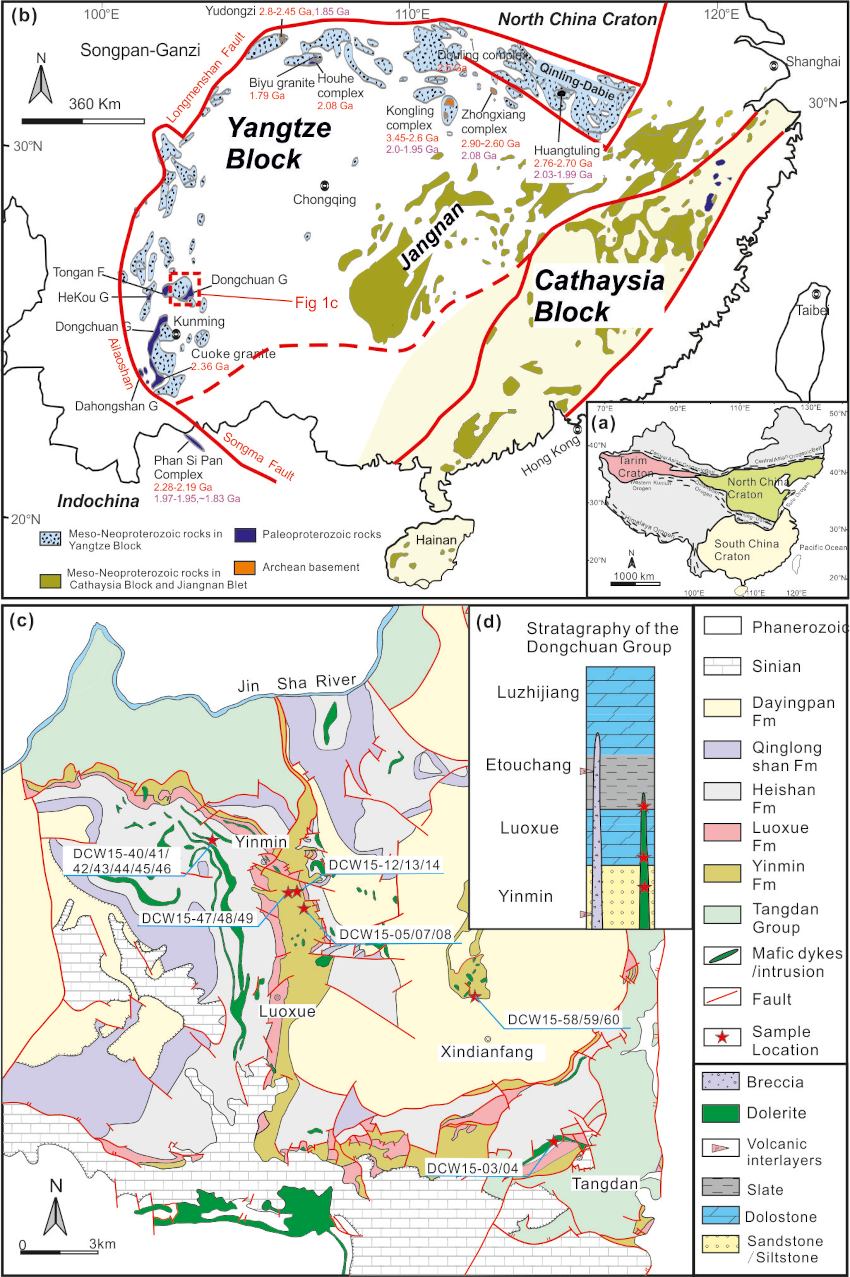
Figure 1. (a). Schematic tectonic framework of China showing three major Precambrian blocks; (b) Outcrops of Archean and Paleoproterozoic basement rocks in the Yangtze Block (modified after Zhao & Cawood. (2012)); (c) Geological map of the Dongchuan area in the southwestern Yangtze Block of South China (modified after 1:50,000 geological map); (d) Simiplified stragraphic column of the Dongchuan Group. Stars reperesent the sample locations.
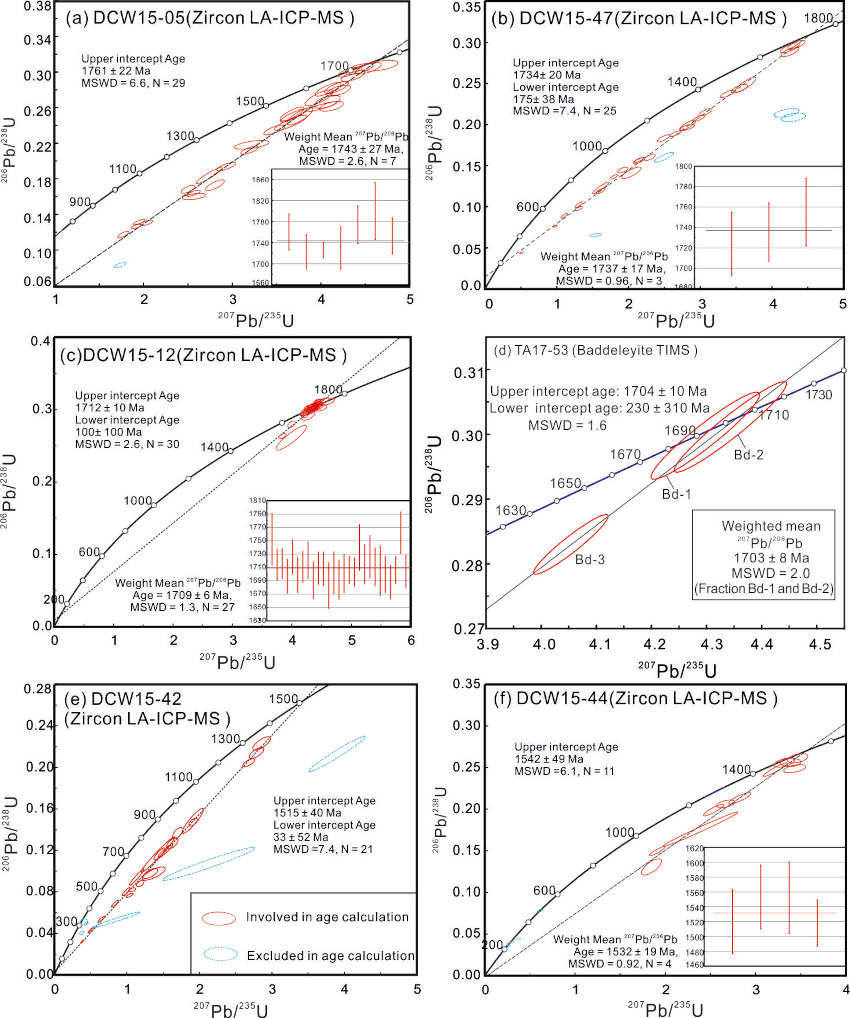
Figure 2. Zircon/baddeleyite U-Pb dating results for the mafic rocks from the Huili-Dongchuan region in South China
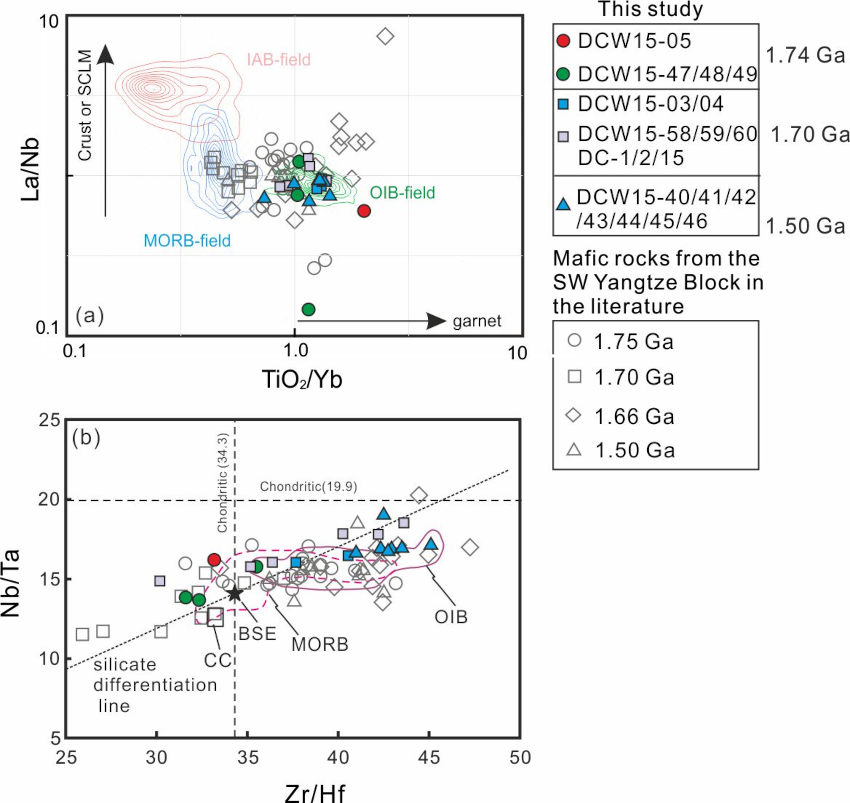
Figure 3. (a) Plots of La/Nb against TiO2/Yb. Notes: Modern-day oceanic island basalts (OIB), mid-ocean ridge basalts (MORB) and island arc basalts (IAB) are from the a comprehensive global petrological databases-GEOROC (http://georoc.mpch-mainz.gwdg.de/georoc/). The orange, blue and green curves represent smoothed kernel density estimates. (b) Diagram of Nb/Ta versus Zr/Hf (after Pfänder et al. (2012));
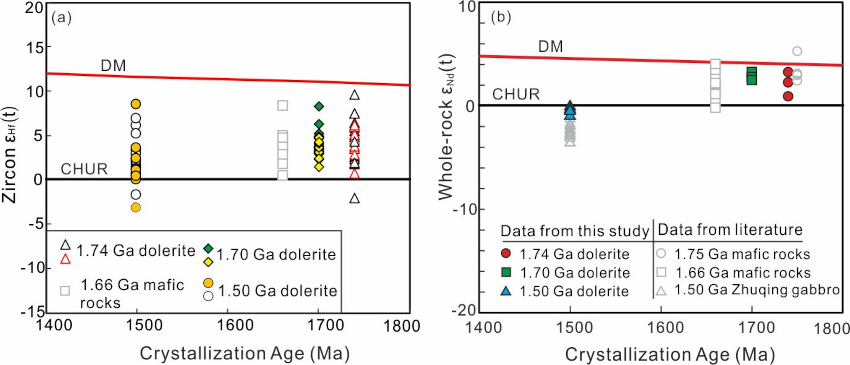
Figure 4. Zircon Hf and whole-rock Nd isotopic compositions for the studied mafic rocks
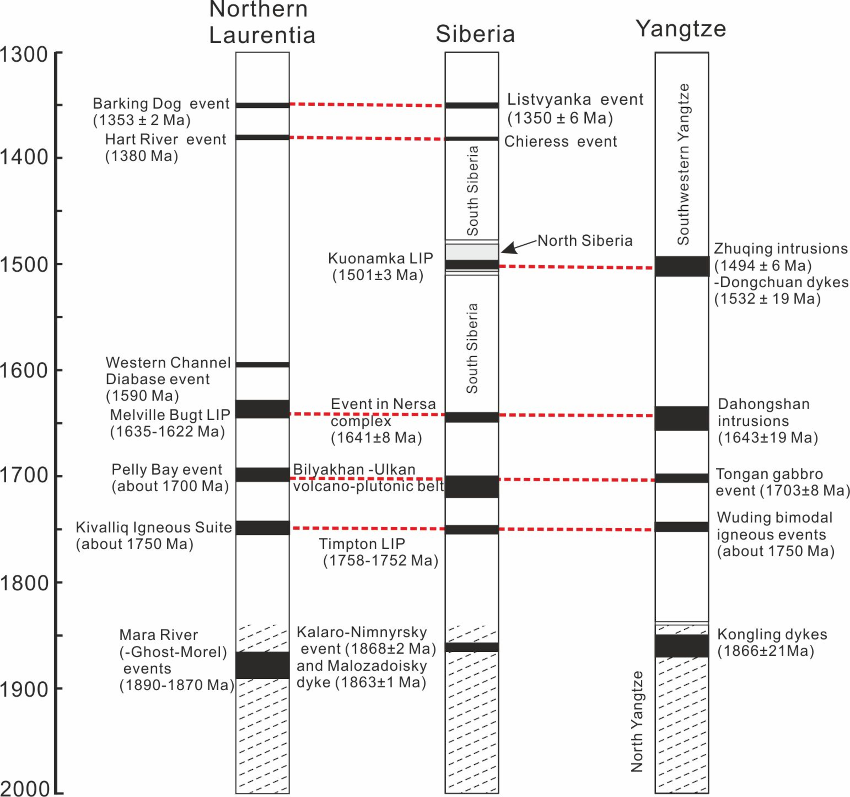
Figure 5. Comparison of the timing of mafic magmatisms between Yangtze, Siberia and northern Lautentia at the period of 1.75-1.50 Ga (modified after Ernst et al., 2016; Lu et al., 2019)
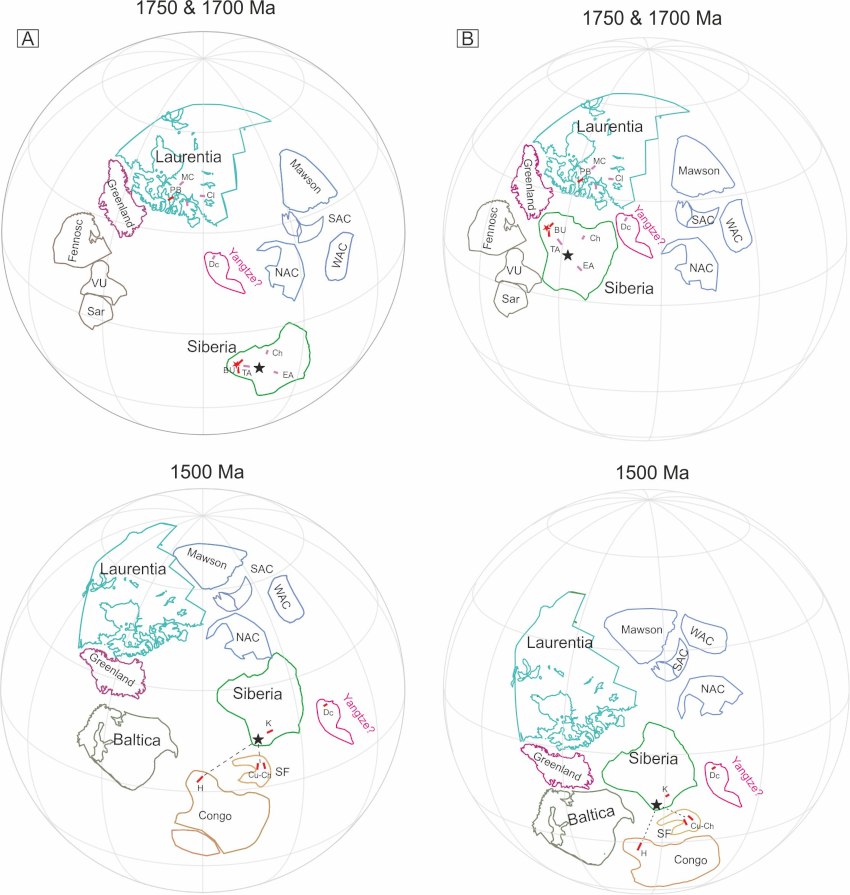
Figure 6. Alternative paleogeographic reconstructions of the Yangtze Block in the Nuna supercontinent at 1.75 Ga and 1.5 Ga. Notes: The left-side reconstruction was done by the GPlates software (Müller et al., 2018), largely based on the work of (Pisarevsky et al., 2014). The paleomagnetic poles and Euler rotation parameters of visualized crustal blocks (except for the Yangtze Block) used in this study are all listed in the Table 1 and Table 2 of (Pisarevsky et al., 2014). The right-side reconstruction is described in Lu et al. (2020). Fennosc= Fennoscandia, VU=Volgo-Uralia, Sar=Sarmatia, NAC=North Australia Craton, WAC=West Australia Craton, SAC=South Australia Craton, SF=São Francisco, NC=North China. The diagrams on the left side feature a significant gap between Siberia and Laurentia (favoured by Pisarevsky et al. 2014) while the diagrams on the rift feature a tight fit of southern Siberia and northern Laurentia (e.g. Ernst et al 2016).
References:
Ernst, R. E., Hamilton, M. A., Söderlund, U., Hanes, J. A., Gladkochub, D. P., Okrugin, A. V., et al. 2016. Long-lived connection between southern Siberia and northern Laurentia in the Proterozoic. Nature Geoscience 9(6), 464-469.
Fan, H.P., Zhu, W.G., Li, Z.X. 2020. Paleo- to Mesoproterozoic magmatic and tectonic evolution of the southwestern Yangtze Block, south China: New constraints from ca. 1.7-1.5 Ga mafic rocks in the Huili-Dongchuan area. Gondwana Research 87, 248-262.
Lu, G-M., Wang, W., Ernst, R. E., Söderlund, U., Lan, Z. F., Huang, S. F., et al. 2019. Petrogenesis of Paleo-Mesoproterozoic mafic rocks in the southwestern Yangtze Block of South China: Implications for tectonic evolution and paleogeographic reconstruction. Precambrian Research 322, 66-84.
Lu, G-M., Wang, W., Cawood, P.A., Ernst, R.E., Raveggi, M., Huang, S-F., & Xue, E-K. 2020. Late Paleoproterozoic to early Mesoproterozoic mafic magmatism in the SW Yangtze Block: Mantle plumes associated with Nuna breakup? Journal of Geophysical Research: Solid Earth, 125, e2019JB019260.
Müller, R. D., Cannon, J., Qin, X., Watson, R. J., Gurnis, M., Williams, S., et al. 2018. GPlates: Building a Virtual Earth Through Deep Time. Geochemistry, Geophysics, Geosystems 19(7), 2243-2261.
Pfänder, J. A., Jung, S., Münker, C., Stracke, A., & Mezger, K. 2012. A possible high Nb/Ta reservoir in the continental lithospheric mantle and consequences on the global Nb budget – Evidence from continental basalts from Central Germany. Geochimica Et Cosmochimica Acta 77(77), 232-251.
Pisarevsky, S. A., Elming, S. A., Pesonen, L. J., & Li, Z. X. 2014. Mesoproterozoic paleogeography: Supercontinent and beyond. Precambrian Research 244, 207-225.
Zhao, G. C., & Cawood, P. A. 2012. Precambrian geology of China. Precambrian Research 222–223, 13-54.
